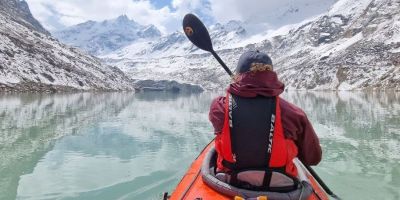Dry times in the Amazon add carbon dioxide to the atmosphere
As the climate changes, the Amazon Basin may release more carbon dioxide into the atmosphere than it absorbs, according to a new study published in the journal Nature.
An international team of scientists, co-led by Professor Emanuel Gloor from the University of Leeds, found that during a dry year the Amazon Basin’s ecosystems ‘exhaled’ more carbon dioxide (through vegetation fires) than it ‘inhaled’ (through photosynthesis). During a wet year, the region was carbon neutral, with roughly equal amounts of carbon dioxide exhaled to the atmosphere and inhaled into ecosystems. “We know that the Amazon undergoes a warming trend similar to the rest of the globe. There is also an increase in both droughts and severe floods. It is unclear how the Amazon forests will change in the future,” said Professor Gloor, one of three lead authors on the new paper. “For the first time we have observed the Basin-wide carbon balance during a very dry and a wet year, which gives us an indication of what changes to expect.”
Until now, scientists have found it difficult to measure the carbon balance of Amazonia at the appropriate scale. Global observations of carbon dioxide concentration are unable to focus on tropical continental regions, and field studies in the Amazon rainforest struggle to scale up to the entire forest biome.
In the new study, precise airborne measurements of carbon dioxide were taken in 2010 and 2011 at multiple sites across Amazonia using aircraft that was outfitted with finely tuned instruments. This data was complemented with ground-based monitoring of the carbon dynamics at a large number of sites across Amazonia, coordinated by researchers at the University of Oxford.
Amazonia is changing. If these trends continue, the region may become a net source of carbon to the atmosphere, moving carbon embedded in ecosystems into greenhouse gas in the atmosphere
Measurements of carbon monoxide were also taken in order to separate fire-related carbon emissions from those associated with plant growth and soil processes, as this gas is a product of biomass burning.
The precipitation patterns during the two years of the study varied considerably: 2010 was extremely dry, while 2011 was very wet.
In 2010, the team found that two processes made the Amazon Basin a net source of carbon for the atmosphere. This was caused by the smoke from fires (which are severe during droughts) exhaling large quantities of carbon. The data gathered from the ground also showed that the drought-stressed vegetation was photosynthesising relatively slowly compared to years of normal moisture, decreasing the amount of carbon that is usually inhaled.
In contrast, 2011 had fewer fires and relatively strong plant growth, which meant that less carbon dioxide was sent into the atmosphere and more was absorbed by growing plants. However, the region did not take up and store more carbon than it sent into the atmosphere. Rather, the Amazon was carbon-neutral, neither adding nor removing carbon from the atmosphere.
“Amazonia is changing. We are observing more very wet years and more very dry years,” said Dr John Miller, from NOAA’s Cooperative Institute for Research in Environmental Sciences (CIRES) at the University of Colorado Boulder and co-lead on the research paper. “If these trends continue, the region may become a net source of carbon to the atmosphere, moving carbon embedded in ecosystems into greenhouse gas in the atmosphere.”
The team will continue the aircraft-based measurements over the Amazon Basin. “We need to understand how sensitive these ecosystems are to climate change, and the potential for feedbacks that could further affect our climate,” said Dr Luciana Gatti, from IPEN, Sao Paulo, Brazil, who co-lead on the research paper. “A longer-term effort will be needed to fully understand the future carbon balance of the region.”
This research was primarily financed by the UK Environmental Research Council (NERC) and the State of Sao Paulo Science Foundation.
Further information
This press release was written in collaboration with NOAA's Cooperative Institute for Research in Environmental Sciences (CIRES), Instituto de Pesquisas energeticas e Nucleares (IPEN), the University of Oxford and the University of Colorado Boulder.
The research paper, ‘Drought sensitivity of Amazonian carbon balance revealed by atmospheric measurements’, was published in the journal Nature on 06 February.
To interview Professor Emanuel Gloor, please contact Sarah Reed, Press Officer, University of Leeds on 0113 34 34196 or email s.j.reed(at)leeds.ac.uk
To interview Dr John Miller, please contact Katy Human, CIRES communications, on +1 303 735 0196 or email Kathleen.human(at)colorado.edu
To interview Dr Luciana Gatti please contact Luciana Gatti, CNEN - IPEN - Atmospheric Chemistry Laboratory on +55 (11) 31339348 or email lvgatti@gmail.com




